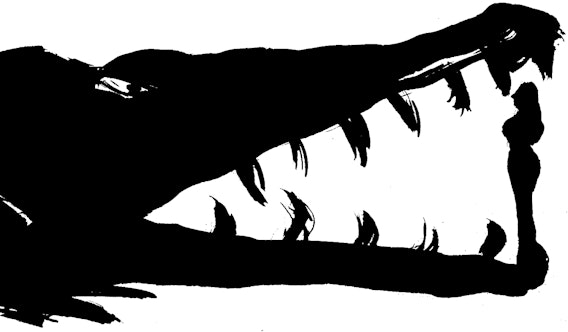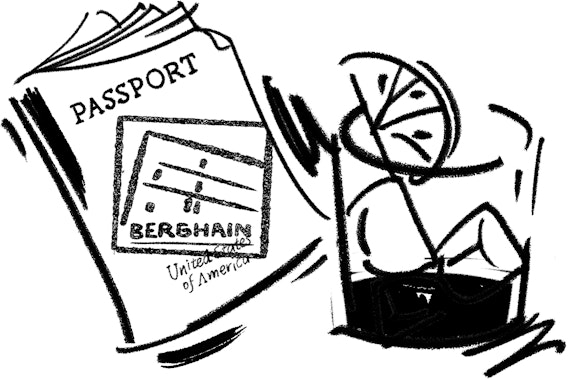Look out lizards! Amateur gunmen stalk the Florida swamps.
On the waterways connecting outer Miami with the Everglades beyond, a silent army of escapee iguanas is on the march. Their precise point of origin, like so much problematic contraband emanating from the city’s docks, is uncertain. However, any naturalist will tell you that iguana iguana is endemic to Central America and the Eastern Caribbean, hence its branding as ‘invasive’ by the Florida Fish and Wildlife Conservation Commission, who have granted a licence to kill to any holidaymaker wishing to atone for their air miles by dispatching some environmental pests.
The severity of the ecological threat posed by the lizards is, perhaps, exaggerated in some quarters, although to question this in conversation with the locals is a faux pas. Being herbivorous, they essentially live like miniature cows, spending their days loafing about and munching the coarse tropical grass which comprises Floridians’ lawns and golf courses. Compared to their invasive partner-in-crime, the all-devouring Burmese python, the iguanas struck me as a somewhat benign presence, although their pariah status was firmly established in 2019 when they burrowed underneath a dam in West Palm Beach, nearly flooding the city in the process.
Existential threat established, enter the Second Amendment crowd. I’d first heard about the bizarre sport some days prior while visiting a friend in Texas. ‘Oh, you’re going to Miami?’, he remarked, before coolly adding, as if suggesting a beach picnic, ‘You should go and shoot these massive lizards they have there. It’s supposed to be fun.’
Later that evening, googling in my hotel room, I saw a macabre succession of images depicting grinning Americans toting these prehistoric-looking reptiles the lengths of their bodies, covered in spines and neon display patches. Curiosity duly aroused, within a few days I found myself disembarking a taxi to rendezvous with my guide, Skipper Steve – bass fisherman turned iguana ghillie.
He arrived, on time but inexplicably drunk, in a fibreglass fishing skiff with a big 350hp outboard engine attached. ‘Come aboard!’ he bellowed, so I embarked gingerly to avoid contact with the mixture of creek water, Bud Light and iguana blood sloshing about in the gull (a pointless endeavour – the first violent burst of acceleration would see to that).
Envisaging an afternoon in the wilds of the Everglades, I had come dressed in a sporty ensemble of khaki trousers paired with a matching safari shirt. I was disappointed to find we had barely left the city centre at all and that the day’s hunt would, in fact, take place amid the low-rise thousing and road junctions that comprise the city’s south-east quarter near the airport. For a moment, the thought crossed my mind that this area was rather too populated to be using the .25-cal telescopic rifle with the ten-round magazine I was presented with, but Steve, insobriety notwithstanding, struck me as a responsible fellow who knew what he was doing. And so, with a jolt as the outboard motor was slid into gear, we departed in search of our quarry.
It did not take long. We encountered our first iguana, a big male, a few hundred metres down the canal. Fearing it might make a run for it, I instinctively stood up and slid a round into the chamber, only to find him unperturbed by our sudden apparition. Nervous, despite the ridiculousness of the situation, I steadied my heartbeat before rattling off the first shot, but it went high, registering with a visible plume of dust just above the creature’s head. The danger of his situation suddenly dawning on him, he reared up on his hind legs and absconded with great pace down the water bank, his front limbs waving crazily in the air. A lucky escape, I thought to myself, or so it seemed until he settled about 30 yards further on, presenting a more technically difficult, but still viable, second shot.
A hollow pop (imagine a tennis ball hitting the floor) sounded from the bank, so I knew I’d plugged him. Stricken, he rotated his whole body in an ultra-high-speed corkscrew motion, paused, took a few tottering steps towards the water, and then collapsed, dead. We stopped to inspect the grim cadaver. ‘He’ll make a beautiful wallet’, Steve remarked, but with the only morgue available to me being my hotel minibar, and a 4,000 mile journey to Heathrow beckoning, I opted for burial at sea instead. I dropped him by the tail into the tea-black canal water and he sank very slowly, turning a couple of times to reveal his pale apricot belly juxtaposed against the dark water, Celine Dion’s My Heart Will Go On playing in my head.
After that it clouded over and the iguanas retreated to their burrows, so we got drunk instead. Steve, steering wheel in one hand and a Modelo Especial in the other, regaled me with stories of his exploits in the brothels of Manaus and his childhood on the Florida Everglades as we sped through the hastening dusk. He was a kind man and clearly a highly accomplished angler. He used to make his money through chartered freshwater bass fishing before the pandemic put a stop to that – now he made his living guiding iguana hunts, finding it easier and more profitable. At one point he removed his baseball camp to reveal an enormous, girthy scar running the length of his head, the sight of which made my stomach leap up to my chest. It genuinely looked as if he had been scalped by an enemy – a nocturnal endeavour in Brazil gone wrong? I opted not to ask. His adolescent pastime of dropping acid and racing speedboats presented itself as another possibility. I recall at one point reaching into a cabinet in search of a bottle opener only to discover instead a 9mm automatic pistol instead. Like the scar, I decided this was best not questioned.
It was dark by the time we got back to the jetty and Steve stayed with me there until my taxi arrived. Driving back through Little Havana, the lights were on and crowds already formed outside the salsa bars. Spanish is the lingua franca of modern Miami and I tried to articulate my murderous outing as best I could. My Honduran taxi registered little reaction, but I knew he understood me because, when I explained that I had made a kill, he enquired eagerly, ‘Do you still have it?’ Sopa de garrobo, or iguana soup, is a delicacy in Honduras, and very difficult to acquire in America.



